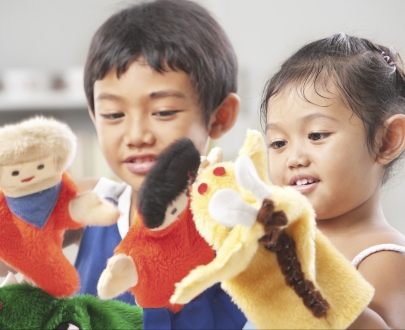Lesson Plan Background & Learning Outcomes:
This activity helps young children learn how to identify the feelings associated with not being able to have something they want. And, the children will review the possible choices of how to deal with wanting something that is not theirs.
Materials:
- paper
- crayons or markers
- 2-3 puppets
Teaching and Learning Activities:
1. ACTIVATE LEARNING: Have children write or draw about a thing or activity they wish they had or could do.
2. Facilitate a conversation with the children about what they wish for or want and why. Share something you wish you could have or do, and why. Ask how it makes them feel?
3. Introduce the concept of comfortable and uncomfortable feelings with the following prompts:
- Name some feelings that are comfortable or that feel good.
- Name some feelings that are uncomfortable or that don’t feel very good.
- When you have comfortable feelings, how might you show them to other people? (e.g., smile, laugh, hug, act friendly)
- How do you think other people feel when we show our comfortable feelings? When you have uncomfortable feelings, how might you show them to other people? (e.g., yell, frown, blush, cry)
- How do you think other people feel when we show our uncomfortable feelings?
- How do you think expressing our feelings might help us get along better with one another? (e.g., understand each other and our differences, communicate better, resolve conflicts better, and share in each other’s excitement more frequently.)
4. Use puppets to play different roles in the following pretend situations:
- Your friend has one of the new action figures that you have been wishing to have for weeks.
- You want to play with your friend, but he has to go somewhere with his family all day.
- A girl in your class who uses a wheelchair has a computer with a game you love to play.
- Your brother just got a great bat and baseball for his birthday … just like the one you want.
- A neighbour child calls you a name that you don’t like.
- Your friend broke your new toy that you got for your birthday.
- Your mom won’t let you go to the movies with your friend’s family.
- Create scenarios inspired by the stories and situations that the children share.
5. Use these questions to help your child think about appropriate choices and behaviours in the role plays above:
- What are the puppets feelings in this situation? How do you know?
- Are the feelings comfortable or uncomfortable?
- What can we do when we want to have someone else’s things? What are our choices? What can we do when someone else is getting to do something we want to do? What are our choices?
Adaptations:
- Have students create their own puppets (using socks, popsicle sticks or paper bags) and use this character in the role plays.
- Using familiar short stories, ask children to draw pictures that illustrate how the main characters feel and use the puppets to act out alternate scenarios for the characters.
- Older children can draw storyboards or create a digital story/dramatization individually or in groups.

